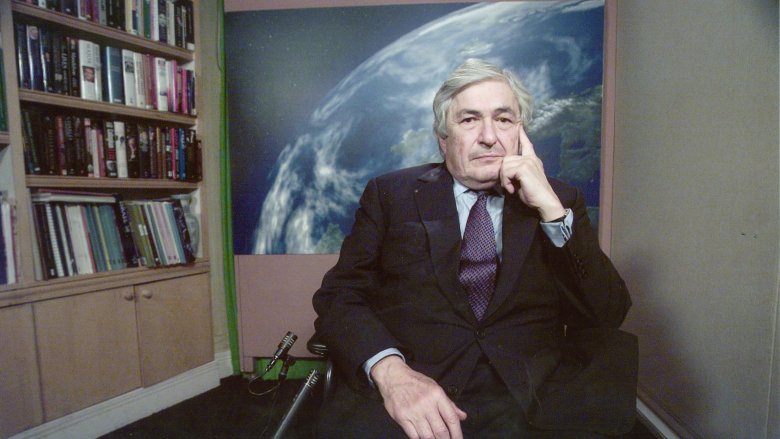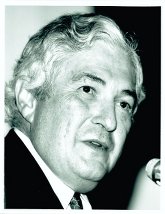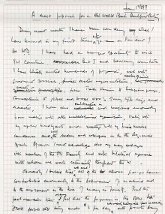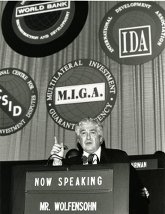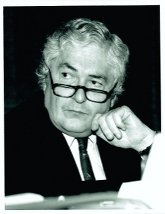Explore History
Remembering President James D. Wolfensohn
On November 25th, 2020, the World Bank Group and the international development community lost a key figure in our field when former Bank Group President James D. Wolfensohn passed away. Wolfensohn arrived at the World Bank Group on June 1, 1995, and over the next ten years he upended much of the Bank’s status quo while reinvigorating staff and development partners alike. Many of the initiatives, projects, and reforms implemented under his leadership continue to inform the Bank Group’s development priorities and practices today. By the time he left the World Bank Group on May 31, 2005, Wolfensohn had left an indelible stamp on our institution.
While these short pieces focus on some of the more well-known and impactful events from President Wolfensohn’s tenure at the World Bank Group, they are only a sample of how the institution evolved during that time. The World Bank Group Archives provides many ways to further investigate the role President Wolfensohn played in our history. We encourage you to check out his profile page on our Past Presidents site and search our World Bank Group Historical Timeline to learn more about Wolfensohn’s time at the Bank Group. You can also browse Wolfensohn’s speeches on our Past President Speeches site or read a first-person account of his experience at the Bank Group in the transcript of his oral history interview on our Oral History site.
And finally, the Archives preserves the records of President Wolfensohn from his time at the World Bank Group and makes them available for public access according to the Bank’s Access to Information Policy. The Archives intends to publish a description of these records on its Archives Catalog website in the near future. But in the meantime, if you are interested in requesting access to President Wolfensohn’s records, submit a request through our Access to Information website.
The legacy of James D. Wolfensohn at the World Bank Group includes a number of ideas and initiatives that pushed beyond financial solutions to enable poverty reduction. One of these was the Comprehensive Development Framework (CDF). Wolfensohn proposed the CDF in a memorandum circulated to the Board and Bank Group personnel on January 21, 1999. The framework was approved by the Executive Directors in March 1999 and, soon after, was implemented as a pilot in over a dozen countries.

Wolfensohn would later describe how the CDF was a deceptively simple concept that was a challenge to implement. In his oral history, he acknowledged that it was “not a brilliant insight. It sounds obvious, but it was bloody hard to get through." The main difficulty was getting the development community to work together. In his remarks during a visit to Vietnam in 2000, he commented that "this question of who coordinates whom [the country or the World Bank Group] has become a key issue, and this accounts, in part, for the sensitivity surrounding the CDF itself."
The creation and implementation of the CDF was a point of pride for President Wolfensohn. Quoting again from his oral history, Wolfensohn shares that, "I can truthfully say that I invented the CDF, sitting in my place in Jackson Hole,” later describing how he scribbled down his ideas for the initiative on a legal pad.
Read a portion of President Wolfensohn's hand-written notes relating to the CDF by clicking on the image of the note pad above or visit this event in the Archives’ Historical Timeline to view a larger selection.
Mounting debt burdens among the Bank Group’s borrowers was one of the many challenges James Wolfensohn faced when he became president of the World Bank Group on June 1, 1995. Rising debt had long been a concern for both member countries and the Bank Group itself, but as the institution marked its 50th anniversary in the mid-90s, it was vital to face the issue head-on.
As economist and former Bank Group Vice President of Financial Policy and Risk Management Johannes F. Linn describes in his oral history, the idea for a more aggressive response to unsustainable debt, which included the possibility of debt forgiveness, had already been discussed in the 1980s and early 1990s. There was, however, considerable resistance from many in the Bank who were concerned that it would, in Linn’s words, “taint all its financial standing” and harm its AAA ratings.
In the early months of his presidency, Wolfensohn pushed staff to develop a creative response to the problem. Ultimately a solution was devised that preserved the Bank’s good standing by using resources made available from the Bank’s net income and contributions from donors to pay off the debt of the poorest countries. The mechanism would become the Heavily Indebted Poor Countries (HIPC) debt relief initiative that was jointly approved by the Bank Group and the International Monetary Fund (IMF) on October 1, 1996.
To learn more about the HIPC Debt Initiative, visit the World Bank Group Historical Timeline, including events on HIPC’s approval and the creation of Multilateral Debt Relief Initiative (MDRI) in 2006. Wolfensohn’s President’s Page also contains discussion of HIPC and its origins.
Corruption, or the ‘c’ word as it had come to be known in the Bank Group, was an issue the organization had been trying to address for many years prior to James Wolfensohn’s arrival in June 1995. Bank Group publications often discussed its impact on the institution’s lending operations while operational policies and governance reform incentives were devised to help minimize its pernicious effects on economic development. However, as a 2004 OED review details, throughout the 1980s and early 1990s Bank Group efforts in the area were limited by an unclear institutional mandate which resulted in a lack of policy framework and appropriate staff skills.
But, he continued, many obstacles still stood in the way of realizing that ideal. “If the new compact is to succeed,” he said, “we must tackle the issue of economic and financial efficiency. But we also need to address transparency, accountability, and institutional capacity. And let’s not mince words: we need to deal with the cancer of corruption.”
Wolfensohn stressed that solutions to identify and eliminate corruption could only be “home-grown”. He emphasized, however, that the World Bank Group was prepared to give advice, encouragement, and support to governments and help put in place both national and international approaches to help fight corruption. Notably, he concluded his discussion of the issue by stating emphatically that “the Bank Group will not tolerate corruption in the programs that we support, and we are taking steps to ensure that our own activities continue to meet the highest standards of probity.”
The World Bank Group dramatically increased its anti-corruption efforts in the years that followed. Most notably, in September 1997 the World Bank Board of Directors approved an anti-corruption strategy, thereby recognizing corruption as a major development issue.
The legacy of the Bank’s leadership on this topic and, specifically, President Wolfensohn’s October 1996 effort to bring corruption out into the open is considerable. It is striking that President Wolfensohn’s “cancer of corruption” speech is cited in the pages of so many reports on the topic. Indeed, in the Bank’s publication, Enhancing Government Effectiveness and Transparency: The Fight Against Corruption, released in September 2020, you will find reference to President Wolfensohn’s speech on page 1.
You can view a clip from President Wolfensohn’s 1996 Annual Meetings speech that contains his discussion of "the cancer of corruption" above or you can access the full transcript of his speech on the World Bank Group's Documents & Reports website. You can also read his thoughts on the importance of effective and transparent governance in his oral history or track his and the Bank Group’s public record on the topic by searching his speeches on the Archives’ Past Presidents’ Speeches page.
